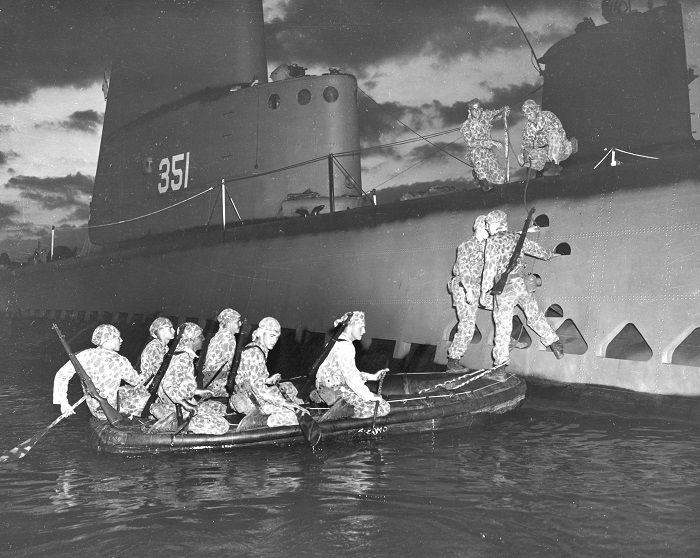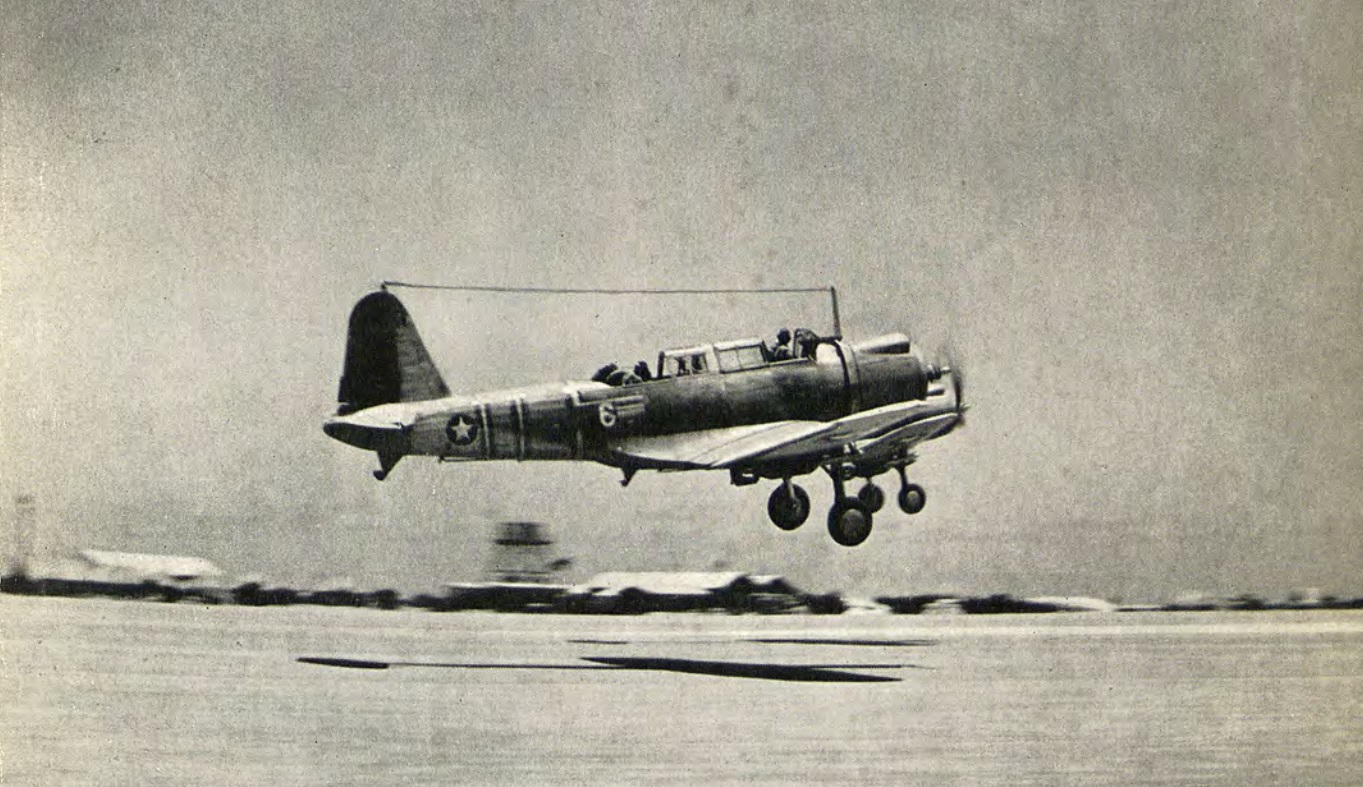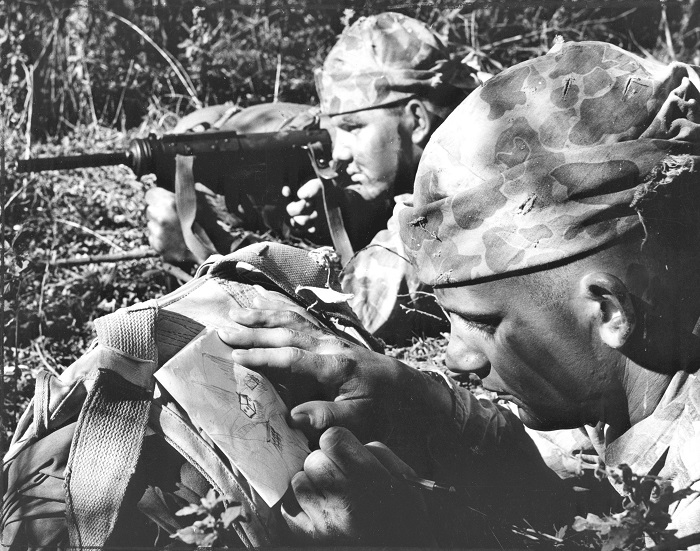Here at LSOZI, we are going to take off every Wednesday for a look at the old steam/diesel navies of the 1859-1946 time period and will profile a different ship each week. These ships have a life, a tale all of their own, which sometimes takes them to the strangest places. – Christopher Eger
Warship Wednesday, July 23, Jules Verne, Meet the U.S. Navy

Here we see the magnificent V-type submarine USS Nautilus (SS-168) in oil on board by the artist I.L. Lloyd depicting the submarine engaging a Japanese merchant ship at close quarters.
Between the two world wars, the U.S. Navy built a collection of nine more or less experimental “V-boat” submarines. These boats took lessons from British and German submarines learned after WWI and incorporated these into a more Yankee design. Each of these subs was very different as the design bureau experimented as they went. One of the ships, V-6, a very close pattern of V-5, which came before her, was built to a submarine-cruiser design.
This concept was a huge sub, meant to have very long legs, and capable of taking the war to the enemy wherever they may be. For this, they were fitted with large, cruiser-caliber guns, and an impressive torpedo battery. Laid down at Mare Island Naval Yard on 2 August 1927, this V-boat (designated V-6/SC-2) was commissioned in June 1930. Following sea trials, V-6 was renamed USS Nautilus (SS-168) on Feb 19, 1931.

Steaming into New York City, 1931. Photo credit: Navsource
The sub was fitted with a pair of massive 6-inch/53 guns in special Mark 17 wet mountings. This gun was designed as a secondary battery of the Lexington-class battle cruisers and South Dakota-class battleships but was only installed in Omaha-class cruisers. Capable of firing a 105-lb shell to a maximum range was 23,300 yd (21,310 m), at the maximum elevation of 25 degrees, they were a hoss of a battery for a boat meant to operate underwater. Except for near-sisters (and fellow V-boats) USS Argonaut (SM-1) and USS Narwhal (SS-167, ex-V-5), the guns carried by the Nautilus were the largest fitted to an American submarine.

To get a feel for how big these guns were, here we see the Nautilus (SS-168) photographed from her sister ship, the Narwhal (SS-167). Photo credit; Navsource.
Capable of traveling an amazing 25,000 nm as long as she kept it slow and filled her ballast tanks with fuel, Nautilus could cross the Atlantic six times without refueling if needed. However, she was meant to operate in the Pacific against a growing Japanese naval threat, and she soon found herself there as the flagship of SubDiv12 at Pearl Harbor. Although her near-sister Narwhal was present there on Dec. 7, 1941 (shooting down two torpedo bombers of the Japanese Combined Fleet), Nautilus was laid up undergoing maintenance back in California.
However, she soon got underway and conducted an amazing 14 war patrols. Nautilus found herself in the middle of the Japanese fleet at the Battle of Midway, firing 5 torpedoes at the battleship Kirishima and the carrier Kaga (with little success due to faulty torpedoes) while surviving 42 enemy depth charges. However, just a few weeks after the battle, she ran across the Japanese Shiratsuyu-class destroyer Yamakaze and sent that ship to Davy Jones approximately 60 nautical miles (110 km) southeast of Yokosuka on 30 June 1945. The photo taken of the Yamakaze sinking after being torpedoed became an instant hit and was used for war bond art.


Yamakaze sinking by Nautilus used in 1943 Electric Boat ad
In August 1942, along with the fellow V-Boat USS Argonaut, the two subs carried elements of the Marine Second Raider Battalion under Lieutenant Colonel Evans F. Carlson to raid the isolated Japanese garrison at Makin Atoll.


Carrying 90 men of Bravo Company, the raid annihilated the small force on the atoll and was a huge propaganda victory for the nation at the time.

U.S. Marine Raiders exercise on the deck of USS Nautilus while en route to the raid on Makin Island on August 11, 1942. And yes, that’s what a 6″/53 Mk17 looks like up close.
Nautilus went back to her life as a fleet submarine but was also pressed back into duty carrying raiders behind enemy lines.
In 1943 she carried 109 Eskimo Scouts to land on the Japanese-occupied Aleutian island of Attu just before the main assault. Then at Tarawa, she put ashore a 77-man group of the 5th Amphibious Reconnaissance Company. Towards the end of the war, she helped carry supplies and recon teams around the Philippines, helping to resupply and tie in local guerrilla groups led since 1942 in many cases by stay-behind (left-behind?) U.S. military members to the effort to liberate the islands.
However, with the war winding down, so did the Navy’s interest in the old and reliable Nautilus. Decommed before the war even ended on 30 June 1945, she was stricken and sold for scrap that Fall after a very hard 15-year life. Her war patrol reports are public record.
Specs:

Displacement, Surfaced: 2,730 t., Submerged: 3,960 t.;
Length 371′ ;
Beam 33′ 3″;
Draft 15′ 9″;
Propulsion, diesel-electric, Maschinfabrik – Augusburg- Nurnburg, New York Navy Yard diesel engines, hp 3175,
Fuel Capacity, 182,778 gal., Westinghouse Electric Co., electric motors, hp 2500, Battery Cells 240, twin propellers.
Speed, Surfaced 17 kts, Submerged 8 kts;
Depth Limit 300′;
Complement 8 officers 80 enlisted;
Armament, four 21″ torpedo tubes forward, two 21″ torpedo tubes aft, four 21″ torpedo tubes topside, 24 torpedoes; two single 6″/53 deck gun, two 30 cal. mgs.;
If you liked this column, please consider joining the International Naval Research Organization (INRO), Publishers of Warship International.
They are possibly one of the best sources of naval study, images, and fellowship you can find http://www.warship.org/
The International Naval Research Organization is a non-profit corporation dedicated to the encouragement of the study of naval vessels and their histories, principally in the era of iron and steel warships (about 1860 to date). Its purpose is to provide information and a means of contact for those interested in warships.
Nearing their 50th Anniversary, Warship International, the written tome of the INRO has published hundreds of articles, most of which are unique in their sweep and subject.
I’m a member, so should you be!




























